Catholic Church

In many ways, Ireland remains a heavily Catholic country.
Yet the emphatic “Yes” vote to same-sex marriage rights on May 22 represents a seismic shift in the nation’s social liberalization and challenges the Roman Catholic Church to rethink its role in Irish society.
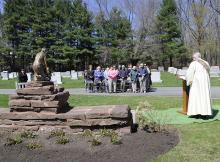
None of the remains of the 26 babies — miscarried, stillborn, and short-lived — whose names are engraved on paving stones or metal butterflies at the Remembrance Garden are actually interred there. But to the families who gathered at the memorial last month, the plot is sacred ground.
“The garden says to us: You matter,” Biskup told them.
“Your baby existed. He or she matters. We remember.”
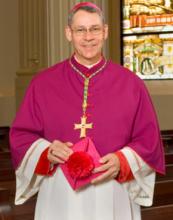
Pope Francis has accepted the resignation of an American bishop who was found guilty of failing to tell police about a suspected pedophile priest.
The Vatican on April 21 said the pope accepted the resignation of Bishop Robert Finn, who led the Diocese of Kansas City-St. Joseph, Mo.
The resignation was offered under the code of canon law that allows a bishop “who has become less able to fulfill his office because of ill health or some other grave cause” to resign.
In 2012, Finn pleaded guilty to a misdemeanor charge for failing to report suspected abuse after the Rev. Shawn Ratigan took hundreds of lewd images of children in Catholic schools and parishes.
Finn became the first U.S. bishop to be convicted in a criminal court of failing to report a suspected abuser and was sentenced to two years’ probation.
Ratigan pleaded guilty to child pornography charges and was sentenced to 50 years in prison.

Pope Francis has repeatedly said he expects his papacy to be a brief one, but Cardinal Walter Kasper is working to ensure that the pontiff’s legacy endures long after this pope leaves the scene.
From the first days of his pontificate two years ago, Francis singled out Kasper for high praise; ever since, the retired German cardinal is frequently known as “the pope’s theologian.”
It’s a moniker the churchman shrugs off with a smile, yet it’s also a label he’s doing nothing to shake, especially in light of Kasper’s most recent book, published last month — a short work that basically describes Francis as a theologian in his own right whose pastoral approach is setting Catholicism on a new course.
The title of the book, from the U.S. Catholic publishing house Paulist Press, says it all: Pope Francis’ Revolution of Tenderness and Love.
But the title also sums up the two-pronged challenge for those, like Kasper, who hope that Francis’ papacy represents lasting change.
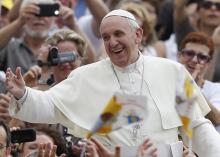
The “Pope of the Interview” strikes again: Pope Francis has given a lengthy — and fascinating — interview to a Mexican television station, which broadcast it on March 13 to mark the second anniversary of his election.
Speaking to the program “Noticieros Televisa,” Francis displays his usual candor, dishing details about the secret conclave that elected him, talking about how he senses his papacy will be short, how the church must get tough on sexual abuse, and how all he really wants “is to go out one day, without being recognized, and go to a pizzeria for a pizza.”
Here are some of the highlights based on Vatican Radio’s English translation and the original Spanish:
On whether he likes being pope:
“I do not mind!”

Chances are you’ll see a bunch of folks walking around with shmutz on their foreheads this Wednesday. The ‘Splainer asks what having a dirty forehead has to do with being a Christian and why this ritual is gaining in popularity.
Q: Excuse me, but why do you have dirt on your forehead?
A: Wednesday is Ash Wednesday, the day many Christians mark as the first day of Lent, the time of reflection and penitence leading up to Easter Sunday. Clergy all over the world dispense ashes, usually made by burning the palm fronds distributed on last year’s Palm Sunday, making the sign of the cross on the bowed foreheads before them. As they “impose” or “dispense” the ashes, the pastor or priest reminds each Christian of Genesis 3:19: “For dust you are and to dust you shall return.”
Q: Well, that’s cheerful. Why would anyone want to start a workday on such a downer?
A: It isn’t intended to be a downer. It’s supposed to be a reminder that our lives are short and we must live them to the fullest. OK, maybe it’s a little bit of a downer — that verse from Genesis is what God said to Adam and Eve when he expelled them from the Garden of Eden for their sins. But there’s a big party the night before Ash Wednesday. That’s Mardi Gras, or “Fat Tuesday,” a secular observance that evolved out of “Shrove Tuesday,” the last hurrah – usually marked by eating of pancakes or other sinfully sweet foods – before the solemnity and penance of Lent set in.
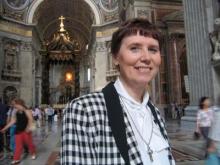
ROME — On its 15 previous pilgrimages, the Catholic gay rights group New Ways Ministry drew maybe two-dozen people to visit holy sites in places like Assisi and Rome.
This year, the number of pilgrims unexpectedly doubled to 50.
Chalk it up to the so-called Francis Effect, where the pope’s open-arms acceptance is giving new hope to gay and lesbian Catholics who have felt alienated from their church for decades.
What’s been even more surprising is that both New Ways and a similar Catholic LGBT organization in Britain are finding support from the Catholic hierarchy in their efforts to meet the pontiff when they both visit the Vatican on Ash Wednesday, the start of Lent, the period of penance and fasting preceding Easter.
For example, Archbishop Georg Ganswein, head of the papal household and the top aide to Pope Emeritus Benedict XVI, responded to New Ways’ request for a papal meet-and-greet by reserving tickets for the group at Francis’ weekly public audience in St. Peter’s Square. It’s not a private meeting — which is tough for anyone to get — but it’s not nothing.
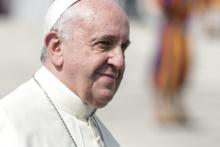
In a powerful sermon that signaled his desire to push ahead with historic reforms, Pope Francis on Sunday said the Roman Catholic Church must be open and welcoming, whatever the costs.
He also warned the hierarchy not to be “a closed caste” but to lead in reaching out to all who are rejected by society and the church.
“There are two ways of thinking and of having faith: we can fear to lose the saved and we can want to save the lost,” Francis told hundreds of cardinals and bishops arrayed before him in St. Peter’s Basilica at a Mass centered on the story of Jesus healing a leper rather than rejecting him.
“Even today it can happen that we stand at the crossroads of these two ways of thinking,” the pope said as he outlined the current debate in the church between those seen as doctrinal legalists and those, like Francis, who want a more pastoral approach.
“Jesus responds immediately to the leper’s plea, without waiting to study the situation and all its possible consequences,” Francis declared. “For Jesus, what matters above all is reaching out to save those far off, healing the wounds of the sick, restoring everyone to God’s family. And this is scandalous to some people!”

In discussing birth control and population issues when visiting the Philippines recently, Pope Francis said the Catholic Church promoted “responsible parenthood” that didn’t require good Catholics to be “like rabbits.” The frank imagery prompted a flurry of playfully creative headlines that ranged from mocking to woeful. And the byproduct of such reaction stories? The continued misinformation on what Catholics currently practice and what the Catholic Church actually teaches when it comes to family planning.
The pope’s remarks referenced Catholic teaching that prohibits artificial birth control. Family size, according to the Church, should be regulated by abstinence or a form of Natural Family Planning, sometimes characterized simply as trying really hard not to have sex when you’re “not supposed to,” which often fails and results in a ton of kids. Proponents of NFP say the method(s), and its practitioners, are too often misunderstood.
NFP for pregnancy prevention involves charting a woman’s cycles by testing for various biological markers — like basal temperature or cervical mucous — in order to assess fertile days and abstain from sex during that time. According to the World Health Organization, fertility awareness methods like NFP are 95-97 percent effective when used correctly and consistently (75 percent with typical use), and individual NFP models claim higher effectiveness.
Practicing NFP can certainly be complicated, especially when taking into account marriage and family dynamics that aren’t always conducive to the attention it requires.
But while it may be more difficult than, say, popping a daily pill or using an IUD, modern technology — like tracking apps and temperature-monitoting gadgets — is simplifying the process and coinciding with a resurgence in popularity. NFP practitioners say they appreciate the choice it offers — whether the motivation is following Church teaching or simply avoiding synthetic hormones.
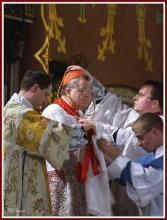
In an online interview this week, Cardinal Raymond Burke said the “radical feminism which has assaulted the Church and society since the 1960s has left men very marginalized.”
But many women will head to Mass this weekend and note that the priest, bishop, and pope have something in common: They are all men, and the power they hold in institutional church structures hardly looks like marginalization.
In spite of Burke’s paranoid opinion that “rampant liturgical experimentation” resulted in men who were “really turned off” by the Mass, women will stand and recite a recently revised Nicene Creed that states that Christ died “for us men.” They will pray to a God referred to only by male pronouns even as God’s gender remains stubbornly mysterious. Even the language of the liturgy negates the presence of women.
Yet Burke is bewildered by women’s “self-focused attitudes” and “constant and insistent demanding of rights.” Women, he said, “respond very naturally to the invitation to be active in the Church.” And yet, when the sanctuary becomes “full of women,” and the parish activities and liturgy are influenced by them, these become “so feminine in many places that men do not want to get involved.”
The fact that Burke gave this interview to a website whose very name — The New Emangelization — may lead many to question whether it is actually a parody, indicates the level of absurdity in Burke’s claims that women have somehow taken over the Catholic Church.
There is also something disturbing and insulting about his ideas concerning the men already in the church.

To much of the country, Cardinal Timothy Dolan has been the conservative face of the American hierarchy, the happy warrior with a big pulpit who led the American bishops during their toughest battles with the Obama administration over contraception policies and gay rights.
But in his own backyard, the current archbishop of New York is much more of a mediating figure, seen as a community leader as well as a churchman. In recent weeks, he’s increasingly stepped up to help ease the festering racial and political tensions between the police and the people, and even between the police and Mayor Bill de Blasio.
"Historically, the archbishop of New York has been an important civic figure," said Paul Moses, a journalism professor at Brooklyn College and Catholic writer whose latest book is "An Unlikely Union: The Love-Hate Story of New York’s Irish and Italians."
After a decade in which Dolan’s predecessor, Cardinal Edward Egan, focused on church administration and avoided the political spotlight, Dolan’s 2009 appointment was aimed at "restoring that role," Moses said.

VATICAN CITY — Pope Francis launched a blistering attack on the Vatican bureaucracy on Monday, outlining a “catalog of illnesses” that plague the church’s central administration, including “spiritual Alzheimer’s” and gossipy cliques.
The pope’s traditional Christmas greeting to the cardinals, bishops and priests who run the Holy See was more “Bah! Humbug!” than holiday cheer as he ticked off a laundry list of “ailments of the Curia” that he wants to cure.
In a critique that left many of the assembled clerics clearly uncomfortable, the 15 ailments in Francis’ “catalog of illnesses” reflected the take-no-prisoners approach he promised when he was elected nearly two years ago as an outsider with little direct experience in Rome.
“The Curia is called upon to improve itself, always improve itself and grow in communion, holiness and knowledge to fully realize its mission,” the pope said.
“Yet like every body, like every human body, it is exposed to illnesses, malfunctioning, infirmity. They are illnesses and temptations that weaken our service to God.”
In a separate address to Vatican staff later, Francis begged pardon for the “shortcomings” of senior church leaders, as well as the “several scandals” that had “caused so much harm,” without specifying which scandals he had in mind.

The Vatican announced Dec. 11 that Pope Francis will name a new batch of cardinals in February, adding to the select group of churchmen who will someday gather to elect his successor.
Rome won’t reveal the names until next month, but could an American be among them?
There are a number of factors that will govern the choices, and thus the predictions:
First, there are 208 cardinals in the College of Cardinals, but at the age of 80 a cardinal is no longer allowed to vote in a conclave. That leaves 112 cardinals under the age of 80, as of now, though two more will age out in February and another two in March and April.
The customary ceiling on the number of electors today is 120 (it has changed many times over the centuries). That means that Francis could give a so-called red hat to 10 or 12 bishops.
The pope could also raise the ceiling, or ignore it, as Saint John Paul II often did during his long reign.
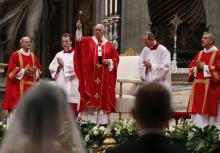
Pope Francis made headlines this week when he officiated at the weddings of 20 couples, including some who had been living together and a woman who has a daughter from a previous relationship.
It was the first time that the Argentine pontiff had presided over a marriage ceremony since his election and it may have also signaled a dramatic shift in Catholic Church doctrine.
Now five conservative cardinals appear to be hitting back.
In a new book to be released days before the world’s Catholic bishops gather at the Vatican for their October Synod, the hard-liners are challenging moves to moderate church doctrine on marriage and offer Communion to divorced Catholics who remarry.
The book, Remaining in the Truth of Christ: Marriage and Communion in the Catholic Church, will be published in five languages, including English and Italian, on Oct. 1.

From the moment news broke that U.S. journalist James Foley had been beheaded by Islamic State extremists in the Middle East, many Christians, especially Foley’s fellow Catholics, began calling him a martyr, with some even saying he should be considered a saint.
Yet that characterization has left others uneasy, and the discussion is raising larger questions about what constitutes martyrdom.
Foley’s parents seemed to validate the martyrdom label when his father, John, spoke at an emotional news conference outside the family’s New Hampshire home and said he and his wife “believe he was a martyr.” Foley’s mother, Diane, added that her son “reminds us of Jesus. Jesus was goodness, love — and Jim was becoming more and more that.”
In an interview two days later with Katie Couric, Foley’s younger brother, Michael, recounted how Pope Francis had called the family to console them and in their conversation “referred to Jim’s act as, really, martyrdom.”
Numerous commentators had already picked up on that idea, holding Foley up not only as a witness to the Christian faith but as a spur for believers in the West to take more seriously the plight of Christians in Iraq and elsewhere in the Middle East who are being persecuted to a degree that some say is comparable to genocide.
But in the Catholic Church, determining whether someone is a martyr is not so easy. Historically, two conditions must be met.
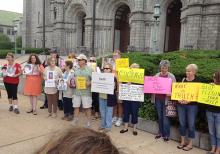
When victims of sexual abuse by Catholic priests first organized into a small band of volunteer activists in the late 1980s, reports of clergy molesting children were still new and relatively few. Most were minimized as anomalies or dismissed altogether — much the way the victims were.
But today, as the Survivors Network of those Abused by Priests, or SNAP, marks its 25th anniversary at a conference in Chicago, its members can take satisfaction in seeing that its claims have been validated, and a few (though hardly all) of its recommendations have been implemented by the church hierarchy.
And instead of facing constant verbal attacks and the occasional angry parishioner spitting on them at a protest, SNAP’s members today are far more likely to receive a handshake and a word of thanks, and maybe even a donation.
SNAP’s advocacy on the Catholic scandal also helped push the reality of sexual abuse into the public consciousness to the point that victims can regularly win in courts and get a hearing in the media, and they are much more likely to come forward to tell their stories, whether they were abused by clergy or by athletic coaches or Boy Scout leaders.
Yet that success is also presenting SNAP with a daunting new challenge as it looks to the future: how to respond to a flood of new inquiries from victims from other faiths and institutions, and how to push for changes beyond the familiar precincts of the Catholic Church.

Today leaders from the Southern Baptist Convention’s Ethics and Religious Liberty Commission (ERLC) and the Southern Baptists of Texas Convention will join the Catholic Bishop of Brownsville in Texas to visit two facilities for migrant children. This is not the first time evangelical and Catholic leaders have worked together on this particular issue—the United States Conference of Catholic Bishops held a joint press call with the Evangelical Immigration Table earlier this year and then together met with members of Congress in March.
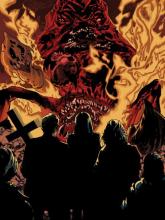
There’s never a better time for a bunch of holy avengers than when all hell actually breaks loose.
The Dynamite Entertainment series The Devilers debuts Wednesday as an action-packed supernatural comic book full of demonic beasties, big-picture philosophies, and heroes that have to put religious differences aside in order to save Vatican City – and the world – from being turned into brimstone.
“When suddenly it’s ‘Oh that is a giant hellmouth that opened up in front of me,’ that changes your beliefs,” said series writer Joshua Hale Fialkov (The Bunker, The Life After), who’s doing the The Devilers alongside artist Matt Triano.
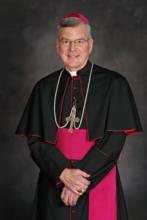
A Roman Catholic archbishop in Minnesota who had been one of the hierarchy’s most vocal opponents of gay rights is the target of an investigation into allegations that he had a series of sexual relationships with priests, seminarians, and other men.
The investigation of Twin Cities Archbishop John Nienstedt is being conducted by a prominent Minneapolis law firm hired by the archdiocese after church officials received an allegation against Nienstedt.
The archdiocese confirmed the investigation, which was first reported by Commonweal, a Catholic magazine based in New York.

A QUESTION ASKED of me 100 times in the last 10 years: Why do you stay in the Catholic Church? How can you stay in a church where thousands of children were raped around the world? Where men in power covered their ears to the screams of children and moved the rapists around from parish to parish so that smiling welcoming parents presented their awed shy children to the rapists like fresh meat? Where women have been marginalized and sidelined for centuries and their incredible creativity diluted and wasted and left to rot? Where power and greed and cowardice so often trumped the very humility and mercy and defiant belief in the primacy of love on which the church was founded and for which it claims to stand today?
Because, I said haltingly, in the beginning, when I was unsure of my honest answer in the face of such rapacious crime and breathtaking lies, because, because ... because how could I quit now? What sort of rat leaves the ship when it is foundering and your fellow passengers need help? Why would I quit now, of all the times to quit? How could I leave the ship in the hands of the men who nearly sank her? How could I abandon the brave honest mothers and priests and nuns and teachers and bishops and dads and monks and children who are the church, who compose the church, who sing the deepest holiest song of the real church?
Because, I said more and more energetically as the years went by, because there are men like my archbishop in my church, men who stood up to lies and crime and accepted the lash of public insult without a word, though the sins were not theirs.